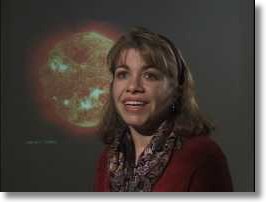|
B a r b a r a T h o m p s o n Solar Physicist SOHO Mission
One of the things that we've learned from the SOHO mission and that we keep on learning
from each solar mission is that the faster you go (i.e. the more observations you make in
a given time period), and the closer you look, there's still lots of activity going on.
It's like the people who discovered that there are cells, and there are viruses and there
are all sorts of things going on in the human body that you would never have dreamt was
going on from looking at a normal person. That's what happening when we observe the Sun.
You look closer, and there's more stuff each time
I am a very strong advocate of the scientific method. The way people think of the
scientific method is that you formulate a hypothesis, then you think about how to test
the hypothesis. Then you try to demonstrate whether the hypothesis is correct or
incorrect. The process is phenomenally exciting. You can formulate the hypothesis that an
eruption contains a billion tons of material, and an idea of how much energy there is
and then actually go and test it by looking at eruption after eruption. So it's not just
that you are taking your theory and you are sitting and consulting your textbooks and
you're sitting there with your pieces of paper. It's a living environment. It's dynamic,
and it's exciting, and you're actually taking that environment and probing it, and trying
to get your answer.
I would say that most of my job actually involves just asking questions and trying to
understand things. But the questions have to be exciting questions to you. You can't be
studying something for 40-50 years if it's a question that you don't find personally
interesting and it does not personally drive you to understand it.
|
